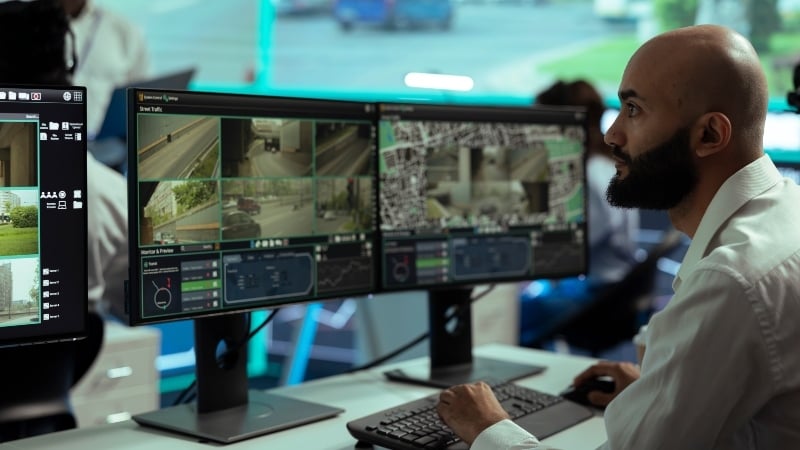Making the Switch: Vendor Transition Guide
Switching fire and security vendors feels risky. Even if your current provider isn't meeting your needs, the thought of transitioning systems and...
 |
Fire protection professionals committed to safeguarding lives, property, and peace of mind. |
 |
Solutions designed for your property type, from multi-family housing to healthcare facilities to retail spaces. |

|
Fire alarm, area of refuge, camera, and card access monitoring services. |
 |
Clear communication and instant response when every second counts. |
 |
From kitchens to server rooms, the right protection for every space. |
 |
Keep your primary defense system ready and reliable. |

|
Manage all your properties' access from one simple platform. |
 |
Monitor multiple properties in real time from anywhere, at any time. |

|
Document upcoming maintenance appointments and improve your proactive budget planning. |
 |
Fire Extinguisher Maintenance Checklist Learn the requirements for testing extinguishers monthly, annually, and beyond. |

|
Track all your inspection deadlines in one place. |
 |
Kitchen Hood Inspection Checklist Ensure your kitchen hoods are safe and compliant. Download a complete list of testing requirements. |

|
Guide to Fire & Security Monitoring Your complete property protection handbook in practical terms. |

|
Running a food truck takes work—this guide gives you the tools to keep it safe and up to code. |
 |
Comprehensive Guide to NFPA 13 and NFPA 25 Fire Sprinkler Systems Navigate sprinkler system requirements with confidence using our straightforward guide to codes and maintenance. |

|
Get your essential compliance guide. |
 |
When reliability matters across 18 restaurants, micromanagement doesn't. |
2 min read
Brothers Fire & Security : May 16, 2025

As your business grows from one location to multiple sites, security becomes trickier. You might initially try managing everything in-house, to save on personnel or hosting costs. While DIY security management might save money initially, the hidden expenses and vulnerabilities often outweigh the perceived savings.
IT knowledge gaps might arise if a staff member leaves. It might be difficult to keep your systems compliant across different municipalities.
Ultimately, the true cost extends far beyond the initial hardware investment. There are real, tangible risks to a DIY approach. And that’s why it’s worth considering whether keeping everything in-house makes sense long-term.
Many businesses calculate the cost of security systems based on hardware expenses. However, the true cost includes several hidden factors:
If an IT member or facility manager leaves your team, they take their knowledge with them (even if it’s well documented). That means you’re potentially losing easy access to credentials and master codes, system configuration details, maintenance schedules and procedures, vendor relationships and contacts, and troubleshooting expertise.
This sudden knowledge gap creates immediate security vulnerabilities—and often requires costly emergency service calls or consultant fees to recover lost information.
Each new location multiplies your security management needs. It also creates new challenges for your security team:
Each municipality may have different compliance requirements for fire safety, security systems, and access control. Without a centralized management system, you could open yourself to fire marshal citations for expired inspections, building occupancy compliance failures, and tracking challenges across multiple compliance engines.
On-premise security systems require significant IT infrastructure at each location, ranging from dedicated servers and hardware, ongoing maintenance and upgrades, physical space requirements, cooling and power costs, backup systems and redundancies.
Some businesses are willing to shoulder these costs for greater internal control. Others might not have the available funding, space, or personnel to manage everything internally. Regardless, as your business grows, these costs multiply with each new location. Plan accordingly.
When evaluating the real cost of DIY security versus partnering with a dedicated security provider, consider these benefits:
When evaluating your security management approach, ask yourself these key questions:
For multi-location businesses, partnering with a security provider that understands multi-site management provides peace of mind and significant cost savings through operational efficiency, consistent compliance, and knowledge gap elimination.
Security management shouldn't be a burden that diverts resources from your core operations. The right security partner transforms security from a constant worry into a seamless service.
Ready to explore how professional security management can transform operations across your locations? Contact Brothers Fire & Security today for a consultation.

Switching fire and security vendors feels risky. Even if your current provider isn't meeting your needs, the thought of transitioning systems and...

Your fire alarm shows a trouble signal. Last week's sprinkler inspection never happened, and despite three calls and multiple messages, your vendor...

Winter weather and holiday demands can make managing multi-location security a nightmare. Fall is your best window to upgrade security systems,...